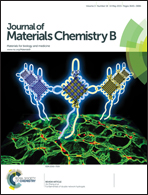Peptide-based biomaterials. Linking l-tyrosine and poly l-tyrosine to graphene oxide nanoribbons†
Abstract
Peptide-based biomaterials are being studied actively in a variety of applications in materials science and biointerface engineering. Likewise, there has been ongoing exploration over the last few decades into the potential biological applications of carbon nanomaterials, motivated by their size, shape, structure and their unique physical and chemical properties. In recent years, the functionalization of carbon nanotubes and graphene has led to the preparation of bioactive carbon nanomaterials that are being used in biomedicine as structural elements and in gene therapy and biosensing. The present study proposes different strategies for the bonding of L-tyrosine and the homopolypeptide poly-L-tyrosine to graphene oxide nanoribbons (GONRs). The covalent attachment of L-tyrosine was undertaken by amidation of the α-amine group of tyrosine with the existing carboxylic groups in GONR and by means of esterification through phenol nucleophiles contained in their side chains. In both cases use was made of protective groups to address the functionalization with the desired reactive groups. The linking of GONRs to the PTyr was attempted according to two different strategies: either by ester bonding of commercial PTyr through its phenol side groups or by in situ ring-opening polymerization of an N-carboxyanhydride tyrosine derivative (NCA-Tyr) with Tyr-functionalized GONRs. These biofunctionalized nanomaterials were characterized by Raman and infrared spectroscopies, X-ray photoelectron spectroscopy, thermogravimetric analysis, transmission electron microscopy, fluorescence and electrochemical techniques. On the basis of their properties, prospects for the potential utilization of the prepared hybrid nanomaterials in different applications are also given.


 Please wait while we load your content...
Please wait while we load your content...